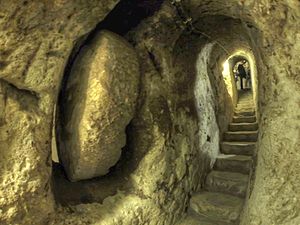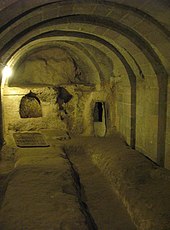Derinkuyu Underground City
Derinkuyu (Turkish pronunciation: ) also known as Elengubu, Cappadocian Greek: Μαλακοπή Malakopi; Turkish: Derinkuyu Yeraltı Şehri) is an ancient multi-level underground city near the modern town of Derinkuyu in Nevşehir Province, Turkey, extending to a depth of approximately 85 metres (280 ft).
It is large enough to have sheltered as many as 20,000 people together with their livestock and food stores. It is the largest excavated underground city in Turkey and is one of several underground complexes found throughout Cappadocia.

Features
The underground city at Derinkuyu could be closed from the inside with large rolling stone doors. Each floor could be closed off separately.

The city could accommodate up to 20,000 people and had amenities found in other underground complexes across Cappadocia, such as wine and oil presses, stables, cellars, storage rooms, refectories, and chapels. Unique to the Derinkuyu complex and located on the second floor is a spacious room with a barrel-vaulted ceiling. It has been reported that this room was used as a religious school and the rooms to the left were studies.
Starting between the third and fourth levels are a series of vertical staircases, which lead to a church on the lowest (fifth) level.

The large 55-metre (180 ft) ventilation shaft appears to have been used as a well. The shaft provided water to both the villagers above and, if the outside world was not accessible, to those in hiding.[citation needed]
History
Caves might have been built initially in the soft volcanic rock of the Cappadocia region by the Phrygians in the 8th–7th centuries BCE. When the Phrygian language died out in Roman times, replaced with the Greek language, the inhabitants expanded their caverns to deep multiple-level structures adding the chapels and Greek inscriptions.
The city at Derinkuyu was fully formed in the Byzantine era, when it was heavily used as protection from Arab Muslims during the Arab–Byzantine wars (780–1180 CE). The city was connected with another underground city, Kaymakli, through 8–9 kilometers (about 5 miles) of tunnels. Some artifacts discovered in these underground settlements belong to the Middle Byzantine Period, between the 5th and the 10th centuries.[citation needed]
These cities continued to be used by the Christian natives as protection from the Mongolian incursions of Timur in the 14th century.
After the region fell to the Ottomans, the cities were used as refuges (Cappadocian Greek: καταφύγια) by the natives from the Turkish Muslim rulers.(p 16)
In the 20th century the underground cities were still used by Cappadocian Greeks and Armenians to escape periodic persecutions. Richard MacGillivray Dawkins, a Cambridge linguist who conducted research from 1909 to 1911 on the Cappadocian Greek-speaking natives in the area, recorded such an event as having occurred in 1909: "When the news came of the recent massacres at Adana, a great part of the population at Axo took refuge in these underground chambers, and for some nights did not venture to sleep above ground."
In 1923, the Christian inhabitants of the region were expelled from Turkey and moved to Greece in the population exchange between Greece and Turkey, whereupon the tunnels were abandoned.
In 1963, the tunnels were rediscovered after a resident of the area found a mysterious room behind a wall in his home while renovating. Further digging revealed access to the tunnel network.
In 1969, the site was opened to visitors, with about half of the underground city accessible as of 2016.[citation needed]
See also
Footnotes
References
Bibliography
- Kostof, Spiro (1989). Caves of God: Cappadocia and Its Churches. Oxford University Press. ISBN 978-0-19-506000-3.
External links

- Cavetowns and gorges of Cappadocia
- Underground Cities of Cappadocia - Myth and Truth(in German)
- Derinkuyu Underground City
- Derinkuyu & The Underground Cities of Cappadocia Sometimes Interesting. 9 May 2014
This article uses material from the Wikipedia English article Derinkuyu underground city, which is released under the Creative Commons Attribution-ShareAlike 3.0 license ("CC BY-SA 3.0"); additional terms may apply (view authors). Content is available under CC BY-SA 4.0 unless otherwise noted. Images, videos and audio are available under their respective licenses.
®Wikipedia is a registered trademark of the Wiki Foundation, Inc. Wiki English (DUHOCTRUNGQUOC.VN) is an independent company and has no affiliation with Wiki Foundation.